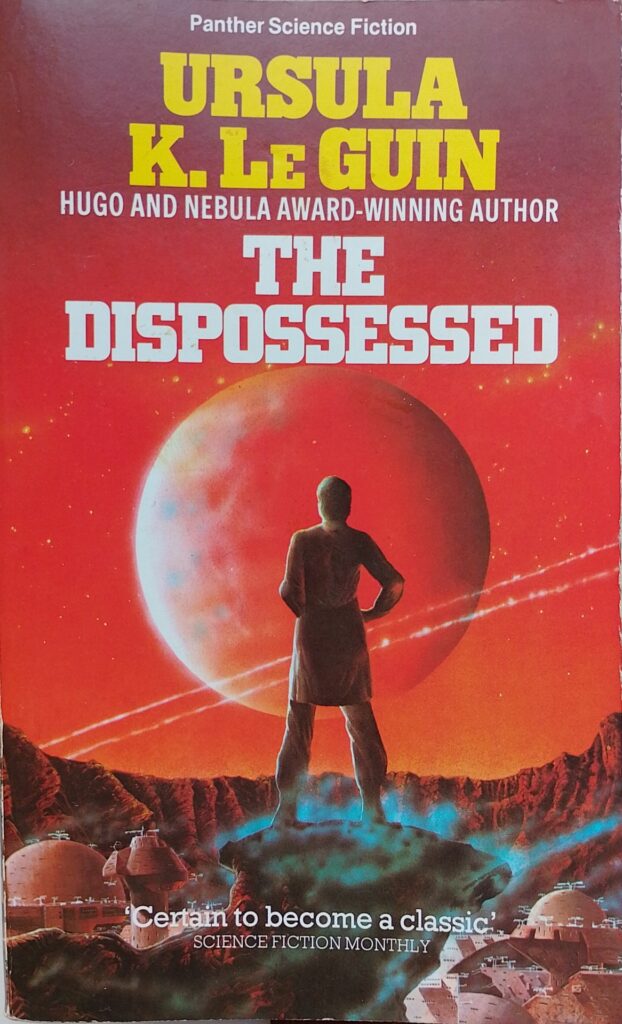First published 1974. Panther paperback, 1984, pp 319, c. 118,000 words.
This is a book more about conflict between ideas rather than people: the cold war, capitalism versus communism, and a strong feminist sub-text. In exploring these ideas, Le Guin doesn’t leap to simplistic solutions or attempt to browbeat with a relentless one-sided message. She can see the flaws in all political systems because they are built on unreliable human beings. Every utopia has its exploiters and backsliders, fanatics and rabble rousers, the lazy and the incompetent, and all are surrounded by outside forces, whether natural or purposeful.
A sun, Ceti, has two habitable planets that closely orbit each other, rather like the Earth and the moon. One, Urras, is a lush rich world where the limited land is divided into conflicting states. All these are, to a degree, capitalist; some dictatorial. There is a clear divide between the well-off and the exploited under-class. Some hundred and fifty years before, a rebel movement grew up, advocating equality through a socially directed anarchy. Eventually this group reached an accommodation with the states and went to the other, uninhabited planet, Anarres; a planet that is a dry and dusty place with a harsh climate and little vegetation. It does have some mineral resources, desired on Urras, which it can exchange for necessities. Apart from this tightly controlled trade, contact between the two planets is almost non-existent. While one might argue about the implausibility of two such similar planets orbiting each other with such very different amounts of water, the set-up is wonderfully drawn.
The principle protagonist is Shevek, a young brilliant physicist of Urras. He is working on unifying the two mainstreams of Cetian physics, which starts as a metaphor for bringing the two planets together, at least in peace if not harmony, and becomes overt. His work is of little practical use to the people of Anarres, but would be of great value to the elites of Urras by facilitating instant communication across space, thereby giving them the edge over the people of the other known star systems: the Hainish and the Terrans. The physics is cleverly done. It is not a direct copy of the physics we know (Terran) but a subtly changed way of interpreting the physical phenomena of the universe, and as a result opens a pathway to faster-than-light communication.
The book is structured as two interleaved periods in the life of Shevek. Initially he is arriving on Urras, the first visitor from Anarres since his people left. He has great hopes of sharing physics and bringing peace. He is warmly greeted and given fine accommodation and a friendly welcome in one of Urras’s most prestigious universities. He is amazed by the luxuries all around and the idyllic setting. Gradually he comes to realise he is being confined, and only seeing the bright side. Here women don’t have jobs, unlike on Annares where women work just as men do, and there is a large under-class who do all the laborious jobs and live in dire poverty.
In the second stream of the book we are given the story of Shevek’s life up to the time of his departure. While he may be a brilliant physicist, his career is stymied by jealous older, senior figures in his field who parasite on his work. As an idealist he also volunteers for harsh manual labour, particularly necessary when the planet is the grip of a drought. A computer is used to supposedly randomly allocate work assignments, with no consideration for keeping families together.
Le Guin’s prose is mostly first rate: easily read and full of meaning. Occasionally the structure becomes rather confusing e.g. ‘…the doctor said, hurriedly, aware that he had been shouting – that he had, Shevek thought, been pounding his hands against the door and shouting…’ [p22]. There are some uncommon words such as ‘nuchnibi’ [p149] and ‘apocopations’ [p164], neither of which are in my dictionary. There are some oddities: the university has a chapel [p176] although there is little other mention of religion. The products and services of these worlds are very 1970’s America. Clothing may be in a jumble of styles but is recognisable, goods are straight 1970s, including an electrical machine to sharpen pencils [p114], and the use of cheques for payment [p183]. How hard it is for an author to escape their present!
Occasionally the writing verges into the preachy: ‘There is not strength to be gained from hurting one another. Only weakness.’ [p186] which has shades of Asimov’s ‘violence is the last resort of the incompetent’. There are frequent passages like: ‘So you threw out all the do’s and don’t’s. But you know, I think Odonians missed the whole point. You threw out the priests and the judges and divorce laws and all that, but you kept the real trouble behind them. You just stuck it inside, into your consciences. But it’s still there. You’re just as much slaves as ever! You aren’t really free.’ [p185].
This is a big book of ideas. Its exploration of political philosophy sometimes drags, slowing the pace of the plot (such as it is). Le Guin always has something interesting to say, her understanding of human behaviour excellent, and mostly her writing style is first class. Oh, and ‘the dispossessed’ can be seen as a good thing: in an anarchy no-one owns anything (although some tend to hoard stuff.)
Wikipedia biography of Le Guin: https://en.wikipedia.org/wiki/Ursula_K._Le_Guin
Wikipedia summary of the book: https://en.wikipedia.org/wiki/The_Dispossessed
Others’ reviews of the book: https://www.goodreads.com/book/show/13651.The_Dispossessed?from_search=true&from_srp=true&qid=EBXKjQO9xw&rank=1
© William John Graham, December 2023

